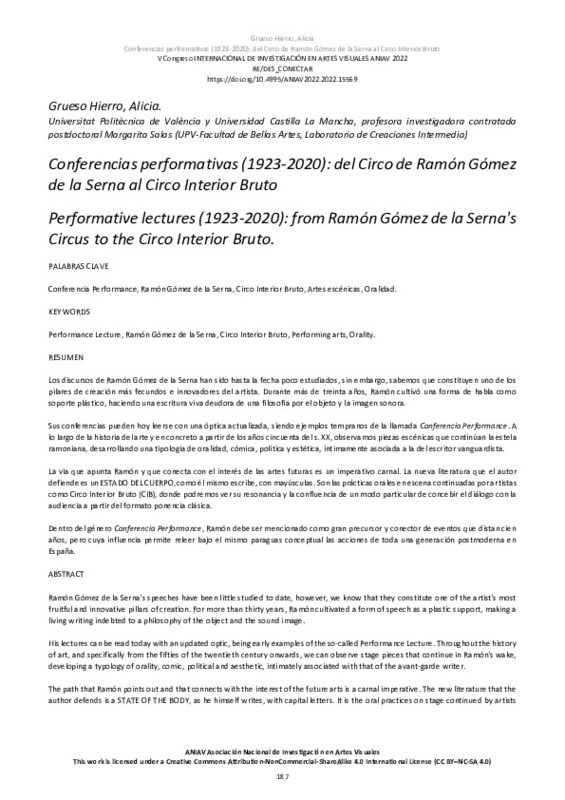|
Resumen:
|
[EN] Ramón Gómez de la Serna's speeches have been little studied to date, however, we know that they constitute one of the artist's most
fruitful and innovative pillars of creation. For more than thirty years, Ramón ...[+]
[EN] Ramón Gómez de la Serna's speeches have been little studied to date, however, we know that they constitute one of the artist's most
fruitful and innovative pillars of creation. For more than thirty years, Ramón cultivated a form of speech as a plastic support, making a
living writing indebted to a philosophy of the object and the sound image.
His lectures can be read today with an updated optic, being early examples of the so-called Performance Lecture. Throughout the history
of art, and specifically from the fifties of the twentieth century onwards, we can observe stage pieces that continue in Ramón's wake,
developing a typology of orality, comic, political and aesthetic, intimately associated with that of the avant-garde writer.
The path that Ramón points out and that connects with the interest of the future arts is a carnal imperative. The new literature that the
author defends is a STATE OF THE BODY, as he himself writes, with capital letters. It is the oral practices on stage continued by artists such as Circo Interior Bruto (CIB), where we can see its resonance and the confluence of a particular way of conceiving the dialogue with
the audience from the classical lecture format.
Within the Performance Lecture genre, Ramón should be mentioned as a great precursor and connector of events that are a hundred
years apart, but whose influence allows us to reread under the same conceptual umbrella the actions of a whole postmodern generation
in Spain.
[-]
[ES] Los discursos de Ramón Gómez de la Serna han sido hasta la fecha poco estudiados, sin embargo, sabemos que constituyen uno de los pilares de creación más fecundos e innovadores del artista. Durante más de treinta ...[+]
[ES] Los discursos de Ramón Gómez de la Serna han sido hasta la fecha poco estudiados, sin embargo, sabemos que constituyen uno de los pilares de creación más fecundos e innovadores del artista. Durante más de treinta años, Ramón cultivó una forma de habla como soporte plástico, haciendo una escritura viva deudora de una filosofía por el objeto y la imagen sonora. Sus conferencias pueden hoy leerse con una óptica actualizada, siendo ejemplos tempranos de la llamada Conferencia Performativa. A lo largo de la historia del arte y en concreto a partir de los años cincuenta del s. XX, observamos piezas escénicas que continúan la estela ramoniana, desarrollando una tipología de oralidad, cómica, política y estética, íntimamente asociada a la del escritor vanguardista. La vía que apunta Ramón y que conecta con el interés de las artes futuras es un imperativo carnal. La nueva literatura que el autor defiende es un ESTADO DEL CUERPO, como él mismo escribe, con mayúsculas. Son las prácticas orales en escena continuadas por artistas como La Ribot, Los Torreznos, Esther Ferrer o Juan Dominguez, donde podremos ver su resonancia y la confluencia de un modo particular de concebir el diálogo con la audiencia. Dentro del género Conferencia Performance, Ramón debe ser mencionado como gran precursor y conector de eventos que distan cien años, pero cuya influencia permite releer bajo el mismo paraguas conceptual las acciones de toda una generación postmoderna en España. El trabajo constatará la supervivencia del orador performativo a través del tiempo. El objetivo será interpretar la nueva oralidad con ejemplos que continúan las características metaoratorias que prefiguró con múltiples intervenciones en directo, Ramón Gómez de la Serna.
[-]
|









